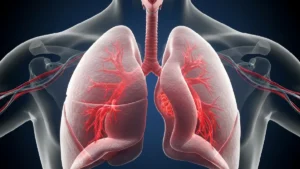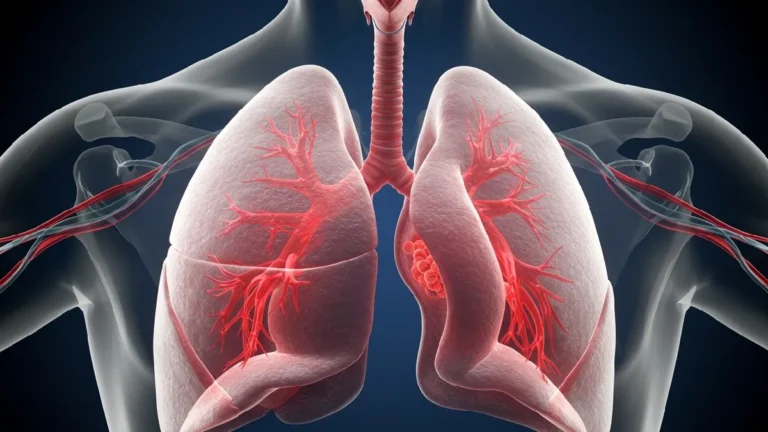Sciatica is characterized by a deep pain that radiates along the sciatic nerve . That is, from the lower back through the hips and buttocks and down each leg .
It’s a type of back pain related to changes in the spine as a result of aging. It usually occurs most frequently after the age of 50, while it’s rare before the age of 20.
Another risk factor for developing lumbago with sciatica is obesity, since excess body weight puts a strain on the spine.
Smoking, a sedentary lifestyle, and the type of profession can also promote sciatic nerve pain.
In this sense, people who adopt an uncomfortable or non-ergonomic working position, remain seated for long periods of time, adopt a flexed or constantly twisted trunk position and/or carry heavy loads have a greater risk of suffering from a pinched sciatic nerve.
Diabetes is also a risk factor for this type of lower back pain, as it increases the risk of nerve injury.
Gender, on the other hand, does not increase the chances of suffering from this condition. Sciatica pain occurs equally in men and women.
Although it resolves in most cases within a few weeks, it can be very debilitating. Therefore, it’s important to know what to do when the first symptoms appear, which sciatica exercises and treatments are beneficial, and when to consult a doctor.
Sciatica: Symptoms Beyond the Pain
In sciatica, the most characteristic symptoms are the presence of intense pain that extends from the lower part of the spine (lumbar) to the buttocks and the back of the leg.
Depending on the nerve root affected, the pain may radiate down the thigh or reach the toes.
The discomfort can be mild or very severe, making it difficult to manage. It may also be accompanied by a burning sensation, a jolt, or an electric shock.
Sciatica is characterized by deep pain in the lower back, buttocks, and leg, often accompanied by an electric shock sensation.
Other associated discomforts include numbness, tingling, or muscle weakness in the affected leg or foot, and functional limitation of the affected limb.
Sciatica symptoms usually occur on one side of the body (right or left leg) and are aggravated by coughing, sneezing, prolonged sitting, or straining or bending the spine forward.
Depending on the cause of sciatica, it may be accompanied by other, much less common symptoms such as additional neurological disorders (urinary or fecal incontinence), weight loss, or fever.
Causes of sciatica
In sciatica, the causes can be very diverse and associated with different diseases or disorders.
– Disc bulge and hernia. Wear and tear on the intervertebral discs causes them to lose strength and elasticity, and some of their fibers may retract or spontaneously rupture. When this happens, some of the disc’s gelatinous contents may bulge (disc bulge) or leak out (disc herniation).
This puts pressure on the sciatic nerve, resulting in pain and other symptoms.
Although this process of disc degeneration is related to the aging process, poor posture, improper loads, lack of exercise, or lumbar injuries or trauma can also cause or precipitate it.
– Lumbar spinal stenosis . Narrowing of the spaces within the spine can put pressure on and pinch the sciatic nerve. Stenosis is primarily associated with wear-and-tear changes in the spine due to aging and osteoarthritis.
– Spondylolisthesis. This is the slippage of a lumbar vertebra that can lead to pinching of the sciatic nerve. It usually occurs in adolescent or young adult athletes.
It tends to be the result of an overuse injury or stress fracture, although it can occur with a single severe impact.
There is also degenerative spondylolisthesis, which usually occurs in patients over 60 years of age with osteoarthritis.
– Piriformis syndrome is a condition characterized by spasm or contraction of the piriformis muscle, located in the buttocks. As a result, it can irritate the sciatic nerve and cause the same symptoms as sciatica.
This is why it is also known as pseudosciatica or false sciatica.
– Pregnancy. Back pain and sciatica during pregnancy are common complaints. Weight gain, the strain of bending over, and the shift in your center of gravity can cause irritation and compression of the sciatic nerve.
Hormonal changes also play a role. In particular, relaxin, a hormone that relaxes the pelvic ligaments and helps prepare the mother’s body for childbirth.
This hormone also loosens the ligaments in the lower back, making them looser and more mobile.
Other possible causes of sciatica include muscle and fascia tension, inflammatory processes such as shingles or radiculitis, circulatory disorders, stress, intense physical work, or Paget’s disease, among others.
Much less frequently, tumors in the back can also cause symptoms of sciatica.
Treatment for sciatica
The best treatment for sciatica begins with prevention through healthy habits such as regular exercise or sports. Especially exercises that promote strong muscles to prevent back pain, such as yoga.
It is also important to avoid a sedentary lifestyle at work and adopt ergonomic postures.
However, it’s not always possible to prevent this condition, and it can recur. If so, there are various treatments available to relieve sciatica pain .
– Relative rest. There is a common question about whether walking is good for sciatica or whether rest is better.
Bed rest is generally not recommended, as it can slow recovery. It should only be advised when sciatica pain is debilitating and no other position is tolerated.
If this is the case, bed rest should not be maintained for more than three days, as this period can lead to muscle weakness, making rehabilitation more difficult.
On the contrary, staying active speeds recovery, reduces pain and its after-effects, and prevents the loss of muscle strength.
The recommendation is to maintain your daily routine as much as possible and increase your activity until you return to normal.
What is not recommended is sports or physical exercise during the first week. After this period, you can begin gentle aerobic activities (walking, cycling, swimming, etc.), followed by core work and other exercises that relieve muscle pain .
– Stretching. Stretching for sciatica can help relieve pain and nerve root compression. These stretches include exercises for the lower back, glutes, and legs that you can do yourself as a self-massage.
– Applying cold and heat. Combining cold and heat for muscle pain is one of the most effective therapeutic measures. In the acute phase, it is advisable to apply cold using compresses, bags, sprays, or other methods several times for about 20 minutes. After two or three days, it is better to apply heat to the painful area. You can also alternate cold and heat.
– Medications. The main medications for sciatica pain are painkillers such as paracetamol, ibuprofen, and naproxen sodium. Muscle relaxants or opioids may sometimes be prescribed.
– Physical therapy. Once the acute pain subsides, physical therapy can help prevent future sciatica by performing exercises that strengthen back muscles and improve flexibility, as well as correcting posture during daily activities.
– Alternative medicine. Some studies suggest that acupuncture for sciatica pain may help alleviate discomfort. Chiropractic may also be effective in managing lower back pain.
– Injections. In some cases, injectable drug treatments are used in muscles, joints, ligaments, and trigger points, or via epidural injections.
– Surgery. When the pain is very severe, uncontrollable with other sciatica treatments, and persists over time, surgical treatment may be considered.
Sciatica symptoms can last for days or weeks. However, you should see a doctor if self-care and/or medication fail to relieve symptoms, sciatica pain persists for four weeks or more, discomfort is severe or debilitating, or if the pain progressively worsens.






















+ There are no comments
Add yours